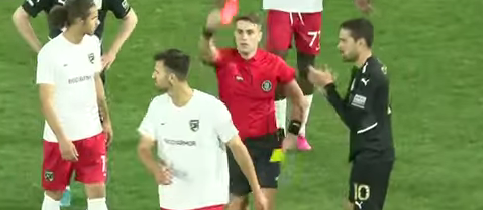UPDATE: In addition to Rodrigo’s da Costa’s successful red card appeal, red cards issued to San Antonio’s Elliot Collier, Rio Grande Valley’s Emilio Ycaza and Hartford’s Peter-Lee Vassell have been overturned on appeal. So four reds have been overturned in total. Of the four, only Collier’s was a straight red; the other three were all second yellows. Interestingly, Collier’s was for foul and abusive language, which is usually very hard to appeal. If anything, this rather reinforces the points we were trying to make in this post.
A lot has been discussed about the number of cards that have been issued in the USL Championship so far this season. So it’s time for the Forge to throw its two cents in.
In the first two weeks of the season we have had 27 games. In those games, 158 single yellow cards have been given. That works out to 5.85 cards per game, or one every 15 minutes and 23 seconds. 9 second yellow cards have been shown, obviously resulting in red cards (although one to FC Tulsa’s Rodrigo da Costa was later rescinded). That’s 0.33 per game, or 1 every 3 games. 5 straight reds have been pulled, 0.19 per game, or 1 every 5.4 games. That’s a total of 14 red cards, slightly more than one every two games. There have also been two games in which 2 red cards were issued (in both cases, one was a second yellow).
Yeah, that definitely seems high. But let’s compare it to last season. In the first 27 games there were 136 single yellows, 1 second yellow and 4 straight reds (the first of which was to the Legion’s JJ Williams, by the way).
Clearly an increase in straight reds from 4 to 5 is not what you would describe as a monumental increase. It’s in the yellow cards where we are seeing the growth. A total of 137 last year and 167 this year, an increase of almost 22%. But looked at another way, that’s just 30 extra cards, which works out to 1.11 more per game.
Again, that’s not really so much of a change. However, I do think that the referees are calling the games a bit more tightly this season and are exerting their authority more intensely. From what I have observed, a good number of the yellow cards shown, especially the first cards, have been relatively soft. That is, in many cases a warning may have been warranted.
And that’s what has led to the increase in second yellows: the players are not adjusting their on-field behavior quite so readily. Soccer is after all a contact sport and if you are used to playing with a certain degree of physicality it’s hard to adapt in response to the way the game is being called. It gets that much easier to get a second yellow. Of course, that doesn’t include ludicrous high studs-up challenges, off-the-ball incidents and other bone-headed actions which we have also seen a few of this season already. Those get you cards under any circumstances.
All told, though, the change in refereeing has not really been anywhere near as severe as gut reactions suggest. The players do need to calm down a bit and the fans definitely need to calm down a lot. And maybe the refs do a tad as well.






